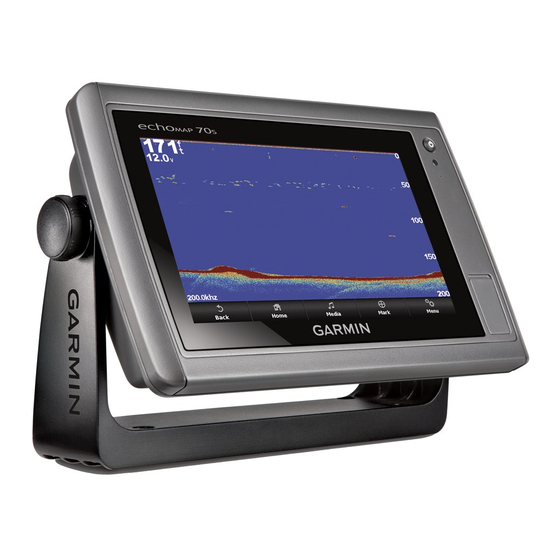from a heading sensor, and GPS heading is calculated by your
chartplotter GPS (course over ground).
1
Select Gauges > Wind > MENU > Heading Source.
2
Select GPS Hdg or Magnetic.
Selecting the Range of the Close-Hauled Wind Gauge
You can specify the range of the close-hauled wind gauge for
both the upwind scale and the downwind scale.
1
Select Gauges > Wind > MENU.
2
Select an option:
• To set the maximum and minimum values that appear
when the upwind close-hauled wind gauge appears,
select Change Upwind Scale, and set the angles.
• To set the maximum and minimum values that appear
when the downwind close-hauled wind gauge appears,
select Change Downwind Scale, and set the angles.
Viewing the Environment Gauges
Select Gauges > Environment.
Configuring the Alignment of the Wind Gauge
You can specify the alignment of the wind gauge on the
environment gauges.
1
Select Gauges > Environment > MENU > Alignment.
2
Select an option:
• To set the top of the wind gauge to a North heading,
select North Up.
• To rotate the gauge so the direction in which you are
moving is at the top, select Head Up.
Configuring the Heading Source of the Environment
Gauge
You can specify the source of the heading displayed on the
environment gauge. Magnetic heading is the heading data
received from a heading sensor, and GPS heading is calculated
by your chartplotter GPS (course over ground).
1
Select Gauges > Environment > MENU > Heading Source.
2
Select GPS Hdg or Magnetic.
Setting the Barometer Reference Time
You can specify the reference time used to calculate the
barometer trend. The trend is indicated in the barometer field.
1
Select Gauges > Environment > MENU > Pressure Ref.
Time.
2
Select an option.
Tide, Current, and Celestial Information
Tide Station Information
You can view information about a tide station for a specific date
and time, including the tide height, and when the next high and
low tides will occur. By default, the chartplotter shows tide
information for the most recently viewed tide station and for the
present date and time.
Select Nav Info > Tides & Currents > Tides.
Current Station Information
NOTE: Current station information is available with certain
detailed maps.
You can view information about a current station for a specific
date and time, including the current speed and level of the
current. By default, the chartplotter shows current information
for the most recently viewed current station and for the present
date and time.
Select Nav Info > Tides & Currents > Currents.
Sonar
Celestial Information
You can view information about sunrise, sunset, moonrise,
moonset, moon phase, and the approximate sky view location
of the sun and moon. The center of the screen represents the
sky overhead, and the outermost rings represent the horizon.
By default, the chartplotter shows celestial information for the
present date and time.
Select Nav Info > Tides & Currents > Celestial.
Viewing Tide Station, Current Station, or Celestial
Information for a Different Date
1
Select Nav Info > Tides & Currents.
2
Select Tides, Currents, or Celestial.
3
Select an option.
• To view information for a different date, select Change
Date > Manual, and enter a date.
• To view information for today, select Change Date >
Current.
• If available, to view information for the day after the date
shown, select Next Day.
• If available, to view information for the day before the date
shown, select Previous Day.
Viewing Information for a Different Tide or Current
Station
1
Select Nav Info > Tides & Currents.
2
Select Tides or Currents.
3
Select Nearby Stations.
4
Select a station.
Viewing Almanac Information from the Navigation
Chart
1
From a chart or 3D chart view, select a location.
2
Select Information.
3
Select Tides, Currents, or Celestial.
When properly connected to an optional Garmin sounder
module and a transducer, your compatible chartplotter can be
used as a fishfinder. There are different sonar views to help you
view the fish in the area.
The adjustments you can make to each sonar view vary
depending on the view you are in and the chartplotter model,
sounder module, and transducer you have connected.
Sonar Views
The sonar views available vary depending on the type of
transducer and optional sounder module connected to the
chartplotter. For example, you can view the DownVü screen
only if you have a DownVü transducer connected.
There are four basic styles of sonar views available: a full-
screen view, a split-screen view that combines two or more
views such as Traditional and DownVü, a split-zoom view, and
a split-frequency view that displays two different frequencies.
You can customize the settings for each view in the screen. For
example, if you are viewing the Split Frequency view, you can
adjust the gain for each of the frequencies separately.
If you do not see an arrangement of sonar views to suit your
needs, you can create a custom Combination screen
a Custom Combination
Screen).
Full-Screen Sonar View
There are several full-screen views available, depending on the
equipment connected. The full-screen sonar views show a large
image of the sonar readings from a transducer. The range scale
Sonar
(Creating
13

